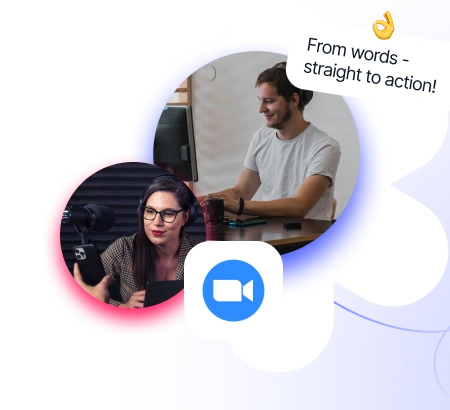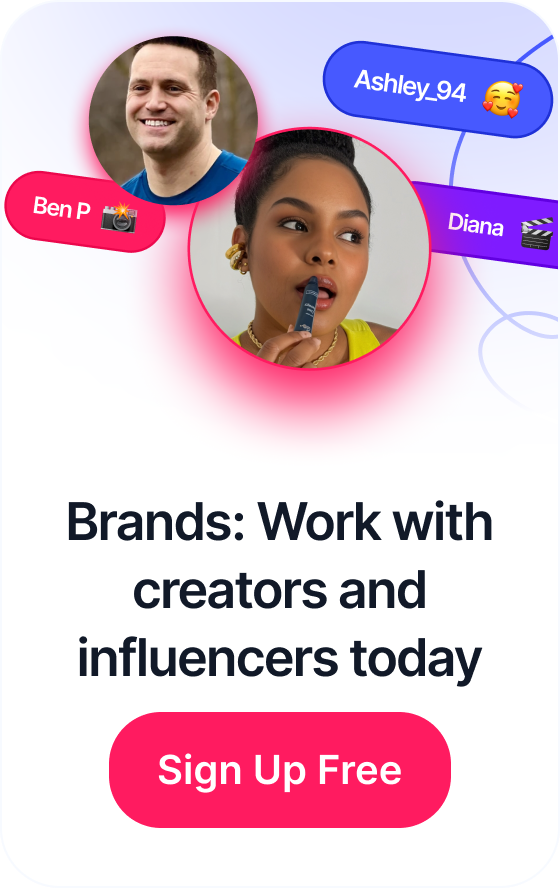 User Generated Videos That Actually Drive Results
User Generated Videos That Actually Drive Results
Here's the simple truth: Affiliate marketing is just a modern, digital twist on getting a commission for recommending something you like. You promote a company's products, and if someone buys through your unique link, you get a piece of the pie.
It's a straightforward way for bloggers, YouTubers, and anyone with an audience to make money from their content.
Table of Contents
Your Guide to Understanding Affiliate Marketing

At its heart, affiliate marketing is all about relationships—a partnership between a brand with a product and a creator with an audience. To really get started, you'll want a solid grasp of the basics, like those covered in this detailed overview of Affiliate Marketing. It's a system that lets businesses tap into trusted voices to drive sales they might not have gotten otherwise.
Let's use an analogy. Imagine you run a popular movie review blog. A new streaming service wants more subscribers and offers you a deal: you get $10 for every single person who signs up using your special link.
You write an honest review, drop in your link, and your readers—who already trust your taste in movies—start signing up. Boom. That's affiliate marketing in action.
The Core Components
But it's not just a two-way street. A few key players have to work together to make the whole thing run smoothly. Figuring out who does what is the first real step to getting good at this.
Affiliate marketing operates on a simple principle of shared success. The brand makes a sale it might not have otherwise, the affiliate earns a commission for their influence, and the customer discovers a new product from a source they trust.
This win-win-win dynamic is why affiliate marketing has absolutely exploded. It’s now a global industry valued at around $18.5 billion and is on track to hit $31.7 billion by 2031.
With over 80% of advertisers running affiliate programs, it’s not some niche strategy anymore; it's a core part of how modern marketing works.
The Key Players in Affiliate Marketing
To really understand what affiliate marketing is, you have to know who's involved. Each player has a specific job, and the system clicks into place when they all do their part.
Here’s a quick breakdown of the essential roles in any affiliate transaction.
| Player | Role | Primary Goal |
|---|---|---|
| The Merchant | The brand or company that creates and sells the product or service. | To increase sales and brand awareness through a wider network. |
| The Affiliate | The individual or publisher who promotes the merchant's product. | To earn commissions by driving traffic and sales for the merchant. |
| The Customer | The end-user who makes a purchase through an affiliate link. | To find reliable products and make informed purchasing decisions. |
| The Network | An optional intermediary that connects merchants and affiliates. | To manage tracking, payments, and program discovery for both parties. |
Think of these four as the essential ingredients. While the network is optional (some brands run their own programs), having one often makes life easier for everyone involved.
The Four Pillars of the Affiliate Ecosystem
To really get what affiliate marketing is all about, you need to know the players involved. The whole system clicks because of the relationships between four key groups. Think of it like a four-legged stool—if one leg is shaky, the entire thing wobbles.
These pillars work together to create a performance-based marketing channel where results are directly rewarded. Each one has a distinct role and motivation, contributing to a cycle that benefits everyone when it’s running smoothly.
This infographic shows the basic flow of how it all connects, from the brand right through to the customer.

As you can see, the affiliate is the crucial bridge, connecting a brand's product with the people who might actually want to buy it.
The Merchant
First up, you've got the Merchant. You might also hear them called the seller, the brand, or the advertiser. This is simply the company that creates the product or service being sold.
Their goal is straightforward: sell more stuff and reach more people without blowing their budget on ads that might not work. Imagine a software company that wants more subscribers but doesn't have a massive marketing war chest. By setting up an affiliate program, they only pay when a promotion leads to a real sale. It's an incredibly efficient, performance-based model, which is why over 80% of brands have jumped on board.
The Affiliate
Next, we have the Affiliate, also known as the publisher or creator. This is the person or company promoting the merchant's product to their audience. Affiliates can be anyone with an online platform—from a niche blogger writing super-detailed product reviews to a TikTok influencer making fun, engaging videos.
Their motivation? To make money from their content and influence. By recommending products they actually use and like, they can earn a commission without the headache of creating a product from scratch. This pillar is really the engine of affiliate marketing, using expertise and audience trust to guide buying decisions.
An affiliate's success is built on authenticity. When an affiliate genuinely helps their audience solve a problem or make a better decision, the sales follow naturally. Trust is their most valuable currency.
The Customer
The third pillar is the Customer—the person who actually clicks "buy." Their experience is at the heart of this whole setup. From the customer's point of view, the affiliate process should feel helpful and natural, not like a pushy sales pitch.
They find a product through a source they trust (the affiliate), click a special link, and buy it from the merchant. The best part? The price doesn't go up for the customer. The affiliate's commission comes out of the merchant's marketing budget, so it's a win for the consumer who gets a solid recommendation.
The Affiliate Network
Last but not least is the fourth (and often optional) pillar: the Affiliate Network. This is basically a middleman, a platform that connects thousands of merchants with countless affiliates. Think of them as the managers or agents of the affiliate world.
Networks handle all the nitty-gritty technical stuff, providing the essential infrastructure for:
- Tracking: Making sure every click and sale is credited to the right affiliate. No guesswork involved.
- Reporting: Giving both merchants and affiliates clean dashboards to see how things are going.
- Payments: Managing all the commission payouts, which saves everyone a ton of administrative headaches.
- Discovery: Acting as a marketplace where affiliates can browse and find new programs to join.
Big names like ShareASale or CJ Affiliate streamline the whole operation, adding a layer of trust and efficiency. While some huge companies run their own programs in-house, networks make affiliate marketing possible for businesses and creators of all sizes.
Okay, let's get into the nitty-gritty of how you actually make money with this stuff. It's one thing to understand the concept of affiliate marketing, but it's another to see how cash goes from a company's pocket into your bank account.
The way you get paid all comes down to the commission model an affiliate program uses. It’s the engine driving the whole system, and there's no single standard. Your earnings are tied directly to what you can get your audience to do.
Let's look at a real-world example. This screenshot is from Amazon Associates, one of the biggest affiliate programs on the planet. Notice how the commission percentages are all over the place depending on the product category.

This just goes to show you need to understand the payment structure before you start promoting anything. You don't want to find out you're earning a measly 1% on a product you’re pouring your heart into promoting.
The Most Popular Commission Models
So, how do merchants decide to pay you? It usually falls into one of a few common buckets. Each one rewards a different kind of result.
Pay-Per-Sale (PPS): The Gold Standard
This is the most common model out there, and for good reason. With Pay-Per-Sale (PPS), you earn a commission only when someone clicks your link and actually buys something.
Think of it this way: if you promote a $100 piece of software with a 30% commission, you pocket $30 for every single sale you drive. Merchants love this because they only pay out after they've made money. It's a true performance-based model and the bedrock of the entire affiliate industry.
Pay-Per-Lead (PPL): Getting a Foot in the Door
Next up is Pay-Per-Lead (PPL). Instead of a sale, you get paid when one of your visitors completes a specific action that turns them into a potential customer for the merchant. No purchase necessary.
What kind of actions? Usually things like:
- Signing up for a free trial
- Filling out a contact form for a quote
- Subscribing to an email newsletter
- Downloading a free guide or e-book
Commissions for PPL are typically smaller than for PPS—a lead isn't a paying customer, after all. But the upside is that it's often a much easier "ask" for your audience, making it a fantastic option if your content is more informational than transactional.
Pay-Per-Click (PPC): Driving Raw Traffic
The last one, Pay-Per-Click (PPC), is a bit of a throwback but still pops up now and then. Here, you earn a tiny fee for every single click your affiliate link gets. It doesn't matter if they buy anything or even sign up. The merchant's only goal is to get eyeballs on their site.
PPC was a bigger deal in the early days of the internet. These days, it's pretty rare because it's so vulnerable to click fraud. You’ll mostly see it used in very specific campaigns where the main goal is just brand awareness, not immediate sales.
To help you visualize how these stack up, here’s a quick comparison of the most common ways affiliates get paid.
Comparing Common Affiliate Commission Models
This table breaks down the pros and cons of each model, helping you figure out which one might be the best fit for your content and the merchants you want to work with.
| Commission Model | How It Works | Best For Affiliates When… | Best For Merchants When… |
|---|---|---|---|
| Pay-Per-Sale (PPS) | You earn a percentage of the total sale amount after a customer makes a purchase. | Your content directly influences buying decisions and you promote high-value products. | Their primary goal is to drive sales and ensure a direct return on their ad spend. |
| Pay-Per-Lead (PPL) | You get paid a flat fee for each qualified lead you generate (e.g., a form submission, trial sign-up). | Your audience is in the research phase and is willing to sign up for free offers or information. | They have a strong sales process to convert leads into customers and want to build their pipeline. |
| Pay-Per-Click (PPC) | You earn a small amount for every click on your affiliate link, regardless of a sale or lead. | You have a massive amount of traffic but lower buyer intent. It's less common today. | Their main objective is brand awareness and driving a high volume of traffic to their website. |
Ultimately, choosing the right commission model is like picking the right tool for a job. A blog that reviews expensive cameras is going to thrive with Pay-Per-Sale. A newsletter about personal finance might do better with Pay-Per-Lead by promoting webinar sign-ups.
This same logic applies across different platforms. Many of the best strategies to make money on YouTube without showing your face, for instance, lean heavily on choosing the right affiliate model for the video's content. Once you get a handle on these payment structures, you can figure out how to monetize just about any kind of audience.
So, What's the Big Deal with Affiliate Marketing Anyway?
Beyond the paycheck, what really makes affiliate marketing such a popular way to build a business? The short answer is freedom. It’s a powerful path to earning an income without the massive hurdles that come with starting a business from scratch.
At its heart, affiliate marketing is a low-risk venture. You don't have to worry about creating a product, storing inventory, or dealing with customer complaints. Your job is all about promotion, which means your startup costs and day-to-day headaches are practically non-existent.
This setup lets you build a business around something you genuinely love. Think about a rock-climbing enthusiast who starts a blog. They share climbing tips and review gear. By simply adding affiliate links for the climbing shoes and harnesses they actually use and recommend, their passion project starts earning money. All without ever seeing a shipping label.
Building a Business That's Flexible and Scalable
One of the biggest draws is the incredible flexibility. As an affiliate, you can work from anywhere with an internet connection. This opens up a lifestyle that isn’t chained to a desk or a rigid 9-to-5 schedule.
The real magic of affiliate marketing lies in its potential for passive income. You can create one great piece of content—like a deep-dive product review or a super helpful tutorial—and it can keep earning commissions for months or even years as new people find it online.
This model is also ridiculously scalable. A single blog post or video can reach thousands, and your earning potential isn't capped by the hours you put in. As your audience grows, so does your income. It's no wonder the industry is booming. On average, brands report an incredible return of $15 for every $1 spent on affiliate marketing, proving just how effective and profitable it can be. You can find more stats on affiliate marketing's growth over at affiliatestatistics.marketing.
The Practical Perks for Creators
If you're a content creator or publisher, the advantages are very real and almost immediate. It allows you to add new income streams and monetize your audience in a way that actually provides them with value.
Here's what that looks like in practice:
- No Product Development: You get to skip the entire lengthy, expensive process of R&D and manufacturing. You can start promoting trusted, established products right away.
- Zero Customer Service: After you make a referral, the merchant handles everything. Shipping issues, returns, product questions—that's all on them, leaving you free to focus on what you do best: creating content.
- Work From Anywhere: Since your business is entirely online, you have the freedom to operate from your home office, a local coffee shop, or a beach in another country.
Of course, picking the right partners is everything. To get off to a strong start, it’s smart to explore the best affiliate marketing platforms that connect creators like you with solid brands. This helps ensure you're working with companies that fit your vibe and offer fair commissions, making the whole journey a lot smoother.
Proven Strategies for Affiliate Success

Alright, you get the "what" of affiliate marketing. Now it's time to master the "how"—and this is where the real work begins. Getting ahead in this space isn't about getting lucky; it's about using proven strategies to build trust, pull in the right people, and get consistent results.
It all boils down to one critical decision that shapes everything else: choosing your niche.
A niche is way more than just a topic. It's the specific audience you're talking to and the problems you're solving for them. The affiliates who really crush it don't just chase the biggest paychecks; they build a business around something they're genuinely passionate and knowledgeable about.
Your authenticity is your secret weapon. When you're promoting products you actually love and use, your recommendations feel real because they are. That passion bleeds into your content, helping you build a loyal community that hangs on your every word.
Find and Vet High-Quality Affiliate Programs
Once you've zeroed in on your niche, the next move is finding affiliate programs that actually fit. Let's be clear: not all programs are created equal. You want to partner with brands that offer high-quality stuff your audience will genuinely find useful.
Vetting these programs is non-negotiable. Look for companies with a solid reputation, fair commission structures, and good reviews from other affiliates. A fantastic product tied to a garbage affiliate program is a recipe for frustration and lost income.
The heart of any great affiliate partnership is mutual value. You're sending the merchant warm, targeted leads, and they're giving you a product you can stand behind and a commission that makes your effort worthwhile.
When you're on the hunt, keep these things in mind:
- Product Relevance: Does this product directly solve a problem for your specific audience?
- Commission Rates: Are the payouts competitive for the industry?
- Cookie Duration: How long do you get credit for a sale after someone clicks your link? Longer is almost always better—aim for 30-90 days.
- Brand Reputation: Does the company have happy customers and a strong presence in the market?
Taking the time to be picky here ensures you're building a sustainable business on a foundation of quality, not just chasing a quick buck.
Create Content That Actually Helps People
At its core, affiliate marketing is just content marketing with a payday. Your main job isn't to sell; it's to help, inform, and guide. Nobody likes an aggressive sales pitch, and it's the fastest way to make your audience tune out. Instead, focus on creating genuinely valuable content that solves their problems.
A smart affiliate knows that the real goal is to attract people with useful information. The foundation for this is a solid content marketing strategy. This is your game plan for delivering value over and over again.
Some of the most effective types of affiliate content are:
- In-Depth Product Reviews: Go way beyond the specs. Share your real experience, point out the good and the bad, and show the product in action.
- Comparison Guides: Help your audience choose by putting two or more popular products head-to-head. Make their decision easier.
- Tutorials and How-To Guides: Show people how to use a product to get a specific result. This builds massive trust and makes you the go-to expert.
- Case Studies: Break down your own success using a product. Nothing beats tangible proof that it works.
When you take this problem-solving approach, your affiliate links feel like helpful resources, not pushy ads. If your audience knows your primary goal is to help them succeed, they'll trust your recommendations and be far more likely to buy.
Build and Engage Your Audience
Making great content is only half the job—people actually have to find it. This is where audience-building comes in. With nearly 49% of brands worldwide partnering with marketers, you need a plan to stand out.
The most powerful tool in your arsenal, used by nearly 70% of affiliates, is Search Engine Optimization (SEO).
Learning the basics of SEO helps your content show up in Google, bringing you a steady flow of free, organic traffic. Beyond search engines, social media platforms are perfect for building a real connection with your community.
Platforms like Instagram and TikTok, for example, are goldmines for visual engagement. Learning how to become a TikTok Shop affiliate can open up a whole new, fast-growing revenue stream.
Finally, always play it straight. Be transparent about your affiliate relationships. A simple disclosure builds the trust you've worked so hard to earn. It’s not just about following the rules; it's about strengthening your bond with your audience and turning followers into a true community.
Debunking Common Affiliate Marketing Myths
Let's be honest, affiliate marketing gets a bad rap sometimes. It’s surrounded by a ton of myths that can easily scare off anyone just starting out. It's time to cut through the noise and get real about what this business model actually looks like day-to-day.
By tackling these misconceptions head-on, you can walk into affiliate marketing with a clear head and the confidence to succeed.
One of the biggest tall tales is that affiliate marketing is some kind of “get-rich-quick” scheme. The reality couldn't be more different. Success isn't about some overnight lottery win; it’s the result of showing up consistently, earning trust, and giving your audience real value over the long haul.
Affiliate marketing is a marathon, not a sprint. Sustainable income comes from building an authentic relationship with your audience, which takes patience and dedication. Expecting instant results is the fastest path to disappointment.
So many aspiring affiliates get discouraged and quit right before they even get started. They buy into the "instant cash" myth and get frustrated when the profits don't pour in overnight. The real success stories are always built on months, and often years, of dedicated work.
Myth: You Need a Huge Following
Here's another one I hear all the time: you need hundreds of thousands of followers to make any real money. While having a massive audience certainly doesn't hurt, it's not the be-all and end-all. In fact, the quality of your audience and how much they engage with you is way more important than sheer numbers.
A small, super-engaged niche audience can be an absolute goldmine. Think about it: a community of 1,000 dedicated followers who hang on your every word is infinitely more valuable than 100,000 random viewers who barely notice you. Those loyal fans are far more likely to buy something you recommend because they see you as a trusted friend, not just another ad. This entire principle is the foundation of modern creator partnerships, which you can see in action on any top-tier influencer marketing platform.
- Engagement Over Numbers: A high engagement rate is proof that your audience is listening and trusts your opinion.
- Niche Authority: When you're the go-to expert in a specific niche, your recommendations carry a ton of weight, which leads to better conversion rates from a smaller group of people.
- Targeted Promotions: You can promote products that are a perfect fit for your audience's problems, making the sale feel more like a helpful suggestion than a pitch.
At the end of the day, your main focus should be on building a strong, genuine connection with the audience you already have, no matter the size. That foundation of trust is what truly powers long-term affiliate success and helps you create a reliable income stream.
Frequently Asked Questions About Affiliate Marketing
As you're gearing up to dive in, a few practical questions are probably bouncing around in your head. Let's tackle some of the most common ones beginners have about what affiliate marketing is really like. Think of this as your final briefing before you get started.
We'll clear up any lingering doubts so you can move forward with confidence.
How Much Can You Realistically Earn as a Beginner?
This is the big question, isn't it? The honest answer is that earnings are all over the map, from a few extra bucks a month to a full-blown income. It really comes down to your niche, how engaged your audience is, the quality of your content, and the commissions offered by the programs you join.
Forget the myth about getting rich overnight. As a beginner, your main job is to build trust and deliver real value. The income is a byproduct of that effort, and it often takes several months to see any meaningful momentum. The money follows the value you create, not the other way around.
Do I Absolutely Need a Website to Start?
While having your own blog or website gives you the most control (and I highly recommend it), it's not the only game in town. Plenty of successful affiliates operate entirely on platforms like YouTube, Instagram, TikTok, or even just a well-crafted email newsletter. A website is a huge asset, but it’s not a non-negotiable starting point.
The core requirement is having a platform—any platform—where you can consistently create value and share your affiliate links with an audience that trusts what you have to say. Your platform is simply wherever your people hang out.
Is Affiliate Marketing Still Profitable Today?
Yes, absolutely. The industry is still growing because it's a true win-win for brands and creators. In fact, you could argue it's more profitable than ever, but the game has changed. Success today isn't about spamming links; it's about building authentic relationships.
If you focus on creating genuinely helpful, high-quality content that solves a real problem for your audience, you can do incredibly well, even in a crowded market. The focus has shifted from just making a sale to being a trusted resource.
What Is an Affiliate Network Versus a Program?
This is a really important distinction to understand.
An affiliate program is run by a single company. A classic example is the Amazon Associates program. When you join, you're partnering directly with that one brand.
An affiliate network, on the other hand, is a big marketplace that hosts thousands of different affiliate programs from all sorts of brands. Think of platforms like ShareASale or CJ Affiliate (formerly Commission Junction). These networks act as the middleman, handling all the tracking, reporting, and payments from multiple brands in one convenient dashboard. It just makes life a lot simpler for the affiliate.
Ready to connect with top creators and amplify your brand's reach? JoinBrands provides the tools and network you need to launch successful affiliate and influencer campaigns. Discover how our all-in-one platform can accelerate your sales today.








